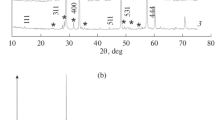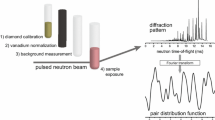Abstract
ESR spectra are presented for pyrolysis residues derived from 5 pre-ceramic polymers: polycarbosilane (PCS), hydridomethylcyclosilazane (HMCS), hydridomethylcyclopolysilazane (HMCPS), polydiphenylsilazane (PDPS) and polymethylsilylethylenediamine (PMSED). The amorphous black and white residues derived from 1100°C pyrolysis in N2 and NH3, respectively, exhibit symmetric peaks with g values of 2.003. This is compatible with values obtained for unpaired spins existing in carbon impurities that remain in the ceramic residues after pyrolysis of the organosilicon precursor polymers. The spin concentrations of black residues obtained from pyrolysis of pre-ceramic polymers at 1100°C in N2 are invariably higher in magnitude than those measured for white-grey residues generated by initial 1100°C-NH3 pyrolysis of pre-ceramic polymers showing that the NH3 pyrolysis removes polymer-associated carbon more efficiently from ceramic residues than 1100°C-N2 pyrolysis. The Si2N2O/Si3N4 powders produced are purer and have lower ESR activity than commercial Si3N4. When the black residues are crystallized at 1550°C under Ar, carbon is removed and the ESR activity reduced. The ESR signal becomes asymmetric and exhibits some partially resolved structure. Crystallization of white-grey residues is accompanied by an overall increase in ESR activity caused in part by the uptake of carbon from the graphite resistance furnace. For the PCS- and PDPS-derived white-grey residues, additional ESR activity probably arises from the creation of defects in the crystalline Si2N2O formed as a result of the 1550°C firing. In general, ESR properties of the pyrolytic residues correlate well with the relative conducting properties of the corresponding ceramic coatings.
Similar content being viewed by others
References
G. D. SORARU, F. BARBONNEAU and J. D. MCKENZIE, J. Mater. Sci. 25 (1990) 3886.
S.-J. TING, C.-J. CHU and J. D. MCKENZIE, J. Mater. Res. 7 (1992) 164.
P. LE COUSTUMER, M. MONTHIOUX and A. OBERLIN, J. European Ceram. Soc. 11 (1993) 95.
S. LIEDTKE, K. JAHN, F. FINGER and W. FUHS, J. Non-Cryst. Solids 97/98 (1987) 1083.
M. R. MUCALO, N. B. MILESTONE and I. W. M. BROWN, J. Mater. Sci. (submitted).
M. R. MUCALO, N. B. MILESTONE, I. C. VICKRIDGE and M. V. SWAIN, ibid. 29 (1994) 4487.
M. R. MUCALO and N. B. MILESTONE, ibid. 29 (1994) 5934.
R. L. PFEFFER, G. J. GERARDI, R. A. LUX, K. A. JONES, E. H. POINDEXTER. W. H. CHANG and R. A. B. DEVINE, Mater. Res. Soc. Symp. Proc. 165 (1990) 227.
Author information
Authors and Affiliations
Rights and permissions
About this article
Cite this article
Mucalo, M.R., Mcgavin, D.G. & Milestone, N.B. Electron spin resonance studies of amorphous and crystallized residues derived from pyrolysis of pre-ceramic polymers. Journal of Materials Science 32, 3271–3276 (1997). https://doi.org/10.1023/A:1018679524083
Issue Date:
DOI: https://doi.org/10.1023/A:1018679524083




